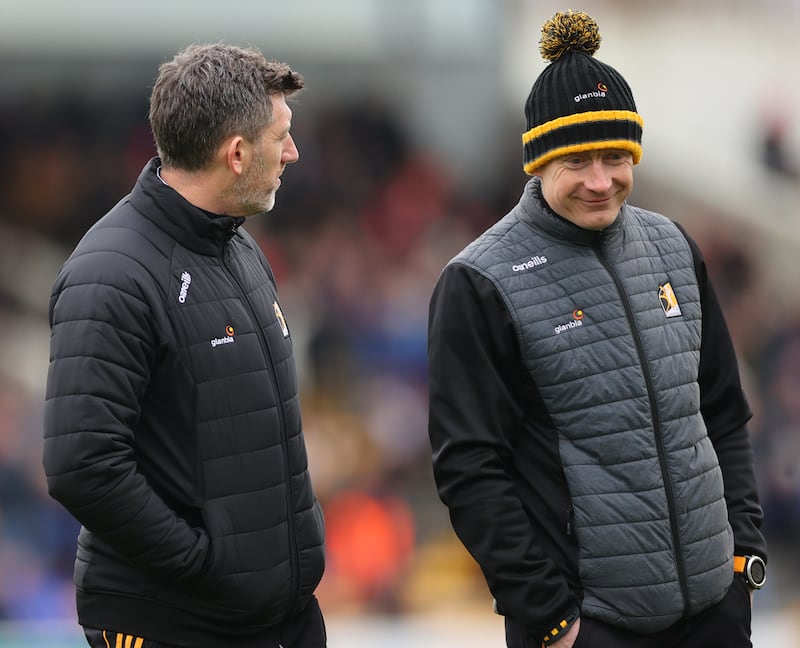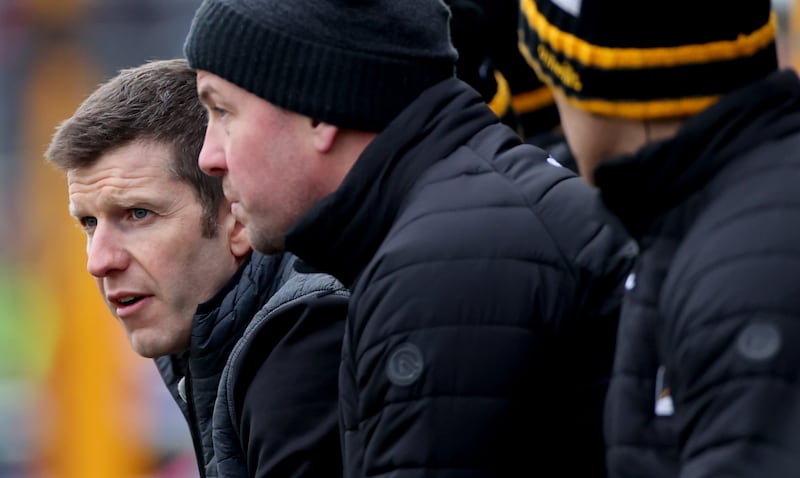The Kilkenny management: an origin story.
In 2001, when Derek Lyng joined the Kilkenny panel as a project player, with no references or standing, Peter Barry was the conscience of the dressing room.
He wasn’t the best player, or the most affecting speaker, and the role had no formal designation, and yet everyone took their cues and their bearings from him.
“He was someone that you aspired to be like,” says Eddie Brennan. “He was someone that you instinctively wanted to follow,” wrote Henry Shefflin in his autobiography.
READ MORE
So, on the long, doleful, bitter, winter runs Barry was at the front of the train, dragging the heavy rolling stock in behind. He was the soul of the hardship too.
Michael Rice tells a story of one of his first training sessions in Nowlan Park, as an unfurnished young player, disorientated from the frenzy, not wanting to stop but failing fast.
“I remember I was out on my feet and Peter Barry was telling me, ‘Stay going, stay going’. And I did stay going – because he was telling me.”
Barry didn’t drink; he minded his diet; he had no airs; his status had no spin-offs or sneaky dividends; he had no relationships with sponsors or the media; he wouldn’t take a bob for presenting medals; he had no truck with the Gaelic Players Association [GPA].
When the Cork and Kilkenny players considered a GPA-inspired protest before the 2002 league final, Barry’s hotly-expressed objection at a team meeting, four days before the game, was regarded by just about everyone in the room as the last word. On the day, only one Kilkenny player broke ranks.
“How I would describe him is a bit like a big brother,” says Brennan. “Looked out for you, minded you, and he also prodded you – to draw it out of you. And yet he was the quintessential big brother because he’d knock lumps out of you if he got a chance. You weren’t going to succeed at his expense, if you know what I mean. That’s a compliment I would pay Peter Barry. He was very good to me over the years, as a friend and a team-mate.”
Lyng was a 24-year-old rookie, whose underage career with Kilkenny had amounted to one fleeting appearance in a long forgotten U-21 match. For years he struggled to find anybody who believed he would amount to anything as a hurler.
Once he landed in Nowlan Park, as one of Brian Cody’s speculative interns, the only way for him to survive was to find a way to improve. He gravitated towards the whetstone.
“Peter was extremely driven,” says Brian Hogan. “He only knew one way and that was flat out. Derek would have been a guy that sought out Peter for drills because that was the way to push your own standards. There was no hiding place with Peter.
“Christ, if we were doing tackling drills, there were certain lads you didn’t want to get. But Derek would have been actively looking for Peter. You’d see the tussles between them – there was only one way.”
Off the pitch, they developed a friendship. They were of the same mind. Part of what they had in common was the mountain below, and how far they had climbed.

Tommy Lannigan taught Barry, Lyng and Rice in St Kieran’s College, and he is a James Stephens club mate of Barry’s.
Rice had a much different trajectory as a young player, but Lyng and Barry were essentially unnoticed. Lyng went through secondary school without making a team in St Kieran’s. Hindsight doesn’t offer another lens; he wasn’t good enough then.
“I remember I had him on a junior panel,” says Lannigan. “He would be on the side of the pitch, beating the ball off the ground, and you could see it off him, ‘Oh God, I want to be out there’. But he was more or less the last sub.
“No one ever doubted his determination or his intelligence or his willingness to go and suffer. He was ferociously determined and a bright fella. He would soak up learning and information, you could always see that in him. But he was always dragged along as kind of a last sub.”
Lannigan was a selector with the Kilkenny minors, too, when Barry was that age.
“I had an awful struggle just to get him on the panel. We needed a full-forward to go to battle – and he played most of his hurling in the forwards at the time. I couldn’t persuade them [the other selectors]. He ended up being number 24 or 25. By his own admission, Peter would have been limited enough skill-wise, but that wasn’t going to stop him. To believe in him you had to know him. His own determination made him a good player.”
Five years later he was on the fringes of the Kilkenny senior panel when word reached Brian Cody’s father, Bill, that Barry was about to be let go. Bill informed the James Stephens chairman who pleaded with the Kilkenny manager, Nicky Brennan, to give Barry one more chance.
In a challenge match against Limerick Barry did enough to earn a reprieve. If he had been dropped then, there wouldn’t have been an uproar.

Rice was different: precocious, flagged, obvious.
“He was a star all the way along,” says Lannigan. “From the age of 14 nobody was in any doubt that Ricey would hurl for Kilkenny. There was no codology about being a superstar, he was a totally level-headed guy. But he had a touch of class about him. Academically, he was very, very bright as well. We always would have said of Ricey in school that by the time he got to Leaving Cert he was more mature than most of the teachers.”
He captained the Kilkenny minors to win the 2002 All-Ireland, their first in nine years. In the GAA victory speeches are full of hand-me-down lines and sentiments, rehearsed and rehashed; Rice, though, deviated from convention.
As a teenager, standing on the podium in the Hogan Stand, addressing the biggest audience he had ever seen, he delivered a speech that was full of personality and thoughtfulness.
After the match, in the warm-up area next to the dressing room, a gang of Kilkenny players hoisted him up on their shoulders and bounced him up and down, chanting his name: “Michael Rice, Michael Rice, Michael Rice…” For teenage boys, it was the easiest way to say how much they cared.
Around the time that Rice was trying to break onto the senior team, though, the Kilkenny four-in-a-row team had just been launched. The positions that Rice coveted were occupied by Lyng, Cha Fitzpatrick, Shefflin, Martin Comerford, Eoin Larkin and Brennan, a barricade of All-Stars and Hall of Famers.
Over three long championship seasons, Rice started just three matches. In Nowlan Park, this was one of the tests: you had to be prepared to wait, and accept that your patience might lead to nothing.
His time came; when Shefflin’s knee folded early in the 2010 All-Ireland final, Rice was his replacement. In the hour that remained he made 18 plays, more than any other Kilkenny player.
Established on the team a year later, he averaged 21 plays a game, exceeding the average of every other Kilkenny player on a team where work rate was a shared fanaticism.
Adversity came to all of them.
“I would say all three went through a ferocious pain barrier,” says Brennan.
Rice suffered two horrific hand injuries, one with UCC early in his career, and another in the 2012 All-Ireland semi-final. The first one required three operations and sidelined him for six months; one of the specialists advised him never to play again. The other required plastic surgery and an extensive re-construction of his hand. He came back from that too.
In Lyng’s case, he was diagnosed with an arthritic hip in 2007, three years before he finished with Kilkenny. Pain management became embedded in his routine.
“He was in a bad way for the last few years,” says Hogan. “If you’re playing in midfield you’re there for your athleticism. A large part of his game was the physicality and energy he brought. So trying to manage a hip, it’s fairly fundamental to what you do, in every aspect. Derek was the kind of character that just got on with it. You wouldn’t have known there was an issue unless you asked him.”
Barry struggled with various ailments in his later years. He woke up on the morning of the 2004 Leinster semi-final with back spasms and played with the aid of injections; in the Leinster semi-final a year later he suffered a freak slap of a sliotar in his private parts and was forced to undergo an operation in the Mater Hospital. He was told to restrict his exercise to slow walking for a fortnight; within a week, he was back training in Nowlan Park.
Cody loved them: not just for their toughness, and their example, and their devotion to the cause, but for how badly they wanted a piece of the jersey.
In his first year on the panel, Lyng was offered a job as a sales rep in Galway. The position came with a spanking new company car, and a massive jump in salary. But work was going to be all-consuming from Monday to Friday, and getting to Nowlan Park from Galway on midweek training nights was out of the question.
Before his three week induction had finished, Lyng raised his dilemma with Cody, knowing in his heart that it was a straight choice: either he wanted the job or he wanted to play for Kilkenny. He returned the car.
Lyng spent six years as a selector under Cody, but as soon as he broke away to manage the U-20s at the end of 2019, it looked like he was auditioning for the big job, whenever a vacancy might arise. Barry, Rice and Peter O’Donovan went with him. Their first two years as a management team left questions; last summer they won the All-Ireland, Kilkenny’s first in that grade for 14 years. When Cody stepped down, there was no mystery about the succession.
Taking over from the most decorated manager in the history of the GAA took courage and confidence and independent minds. It is still early days and it remains a delicate operation. They needed to impose their own identity on the team without losing the principles of behaviour that Cody had curated for a quarter of a century.
“They would epitomise old school values,” says Brennan, “but in the modern way. And one thing about the three of them – you might say everyone has a level of ego, but these boys would have no ego in this regard. This is for the betterment of Kilkenny hurling and the Kilkenny jersey – that would be their only motivation.”
In safe keeping.












